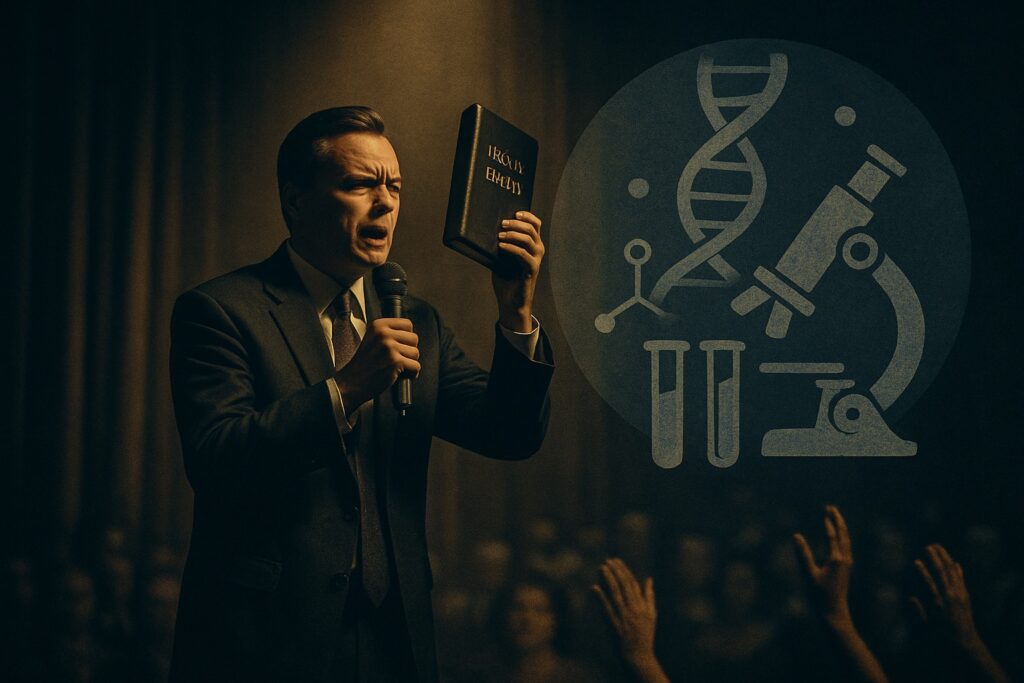
Across many faith traditions, stories of miracle healing are seen as proof of divine power. Television preachers, revival events, and YouTube prophets often claim to cure everything from cancer to paralysis. These claims are made live on stage, with cameras rolling, crowds cheering, and donation lines forming.
Similar stories are shared in churches and across the internet. People talk about tumors disappearing after prayer, pain vanishing during healing events, or wheelchair users standing up and walking after a preacher touches them. These moments are celebrated as signs of divine power, but they are almost never backed up by proper medical records or independent checks.
Selling Hope, Blaming the Sick
Many miracle healing ministries are built on one core claim: God heals those who have strong faith. The hidden message behind this is harsh. If you are not healed, it must mean your faith is too weak or your sins are too great.
People are often asked to make a donation before they can receive healing. This is called sowing a seed. They are told to activate their faith and trust that God will respond. The stage is prepared, the cameras start rolling, and the performance begins.
When Miracles Fail the Test
Scientific research points in a different direction. While prayer can offer emotional comfort, studies have shown it does not lead to consistent or repeatable healing results.
One major study, funded by the Templeton Foundation and known as the STEP study, looked at heart surgery patients. It found no benefit from intercessory prayer. In fact, patients who knew they were being prayed for sometimes had slightly worse outcomes.
Benson et al., STEP Study, American Heart Journal (2006):
https://www.americanheartjournal.com/article/S0002-8703(06)00229-5/fulltext
Other reviews, such as one published in the British Medical Journal, found that many healing claims lack proper documentation and can even cause harm when people stop medical treatment prematurely.
British Medical Journal (BMJ), 2010:
https://www.bmj.com/content/341/bmj.c3986
“If healing must be bought, it is no longer medicine. If belief is blamed when healing fails, it is no longer love.”
Real-World Case: Peter Popoff — The Discredited “Faith Healer”
Peter Popoff was a televangelist who claimed he knew people’s illnesses through divine insight. But in 1986, skeptic James Randi exposed him as a fraud. Popoff was using a hidden earpiece to hear his wife feeding him information that staff had secretly collected from the audience. These were not messages from God.
With this setup, he could call out specific illnesses and perform staged healings on stage. The act made him more famous and brought in large donations.
Sources:
CBS News: Peter Popoff Exposé (1986)
James Randi, The Faith Healers (1987)
Even after being exposed, Popoff made a comeback on YouTube and late-night TV, where he began selling miracle spring water. It’s a clear reminder that emotional desperation can often matter more to people than solid evidence.
A Rational Lens on Healing
Healing is understood as a collaboration built on honesty, science, and real care. It is not a show. Taking advantage of people’s desperation to gain followers or collect money is not an act of faith. It is exploitation.
- Healing is earned through evidence-based treatment and support, not sold or performed.
- We never shame those who remain unhealed; we stand with them.
- Hope is never a tool for guilt, blame, or profit.
- Miracles are not measured by applause; truth aligns with reality.
Prayer and Miracle Healing: The Connection
Prayer is often central to miracle healing claims. Many faith traditions teach that divine power can cure illness through prayer. People gather in churches, healing crusades, or online to pray for themselves or loved ones, seeking signs of divine intervention.
While prayer offers hope and comfort, it’s essential to ask: does prayer alone reliably produce the physical healings it promises?
What Science Really Says About Prayer and Healing
Scientific studies repeatedly show that prayer, despite its emotional benefits, does not produce consistent healing outcomes.
- The STEP study found no benefit from intercessory prayer for heart surgery patients; some who knew they were prayed for had worse outcomes.
- Other reviews found that healing claims often lack medical documentation and can result in harm if people abandon treatments.
Benson et al., STEP Study, American Heart Journal (2006)
British Medical Journal (2010): Review of faith healing claims
Why Do People Still Pray?
Despite the lack of scientific proof that prayer heals physical illness, many continue to pray because:
- Emotional Comfort & Coping: Prayer calms anxiety and offers a sense of control.
- Community & Belonging: Group prayer provides social support, boosting mental well-being.
- Faith & Meaning: Prayer fosters hope and a spiritual connection even if it doesn’t cure illness.
However, it is important to recognize that not everyone finds prayer comforting or helpful. For those with different beliefs, unsolicited prayer can feel intrusive or even insulting. Respect for individual beliefs and consent is crucial when offering spiritual support.
Scientific trials show no evidence that prayer improves medical outcomes, but its psychological and social effects vary widely depending on personal beliefs.
Sources:
JAMA: Prayer and Healing — Medical Outcomes Study
NCBI: Meta-Analysis of Distant Intercessory Prayer Studies
PubMed: Prayer and Health Review
The Lesson
Faith should bring comfort to those who are suffering, not make money off them. When healing turns into a transaction or a public show, it is no longer true healing. It becomes a performance.
Real hope includes facts. Real healing includes science. Pungwenism calls for compassion without illusion and truth without performance.
References
- Benson et al., STEP Study, American Heart Journal (2006)
- British Medical Journal (2010): Review of faith healing claims
- CBS News – Peter Popoff exposed (1986)
- Randi, J. The Faith Healers, Prometheus Books (1987)
- Coyne, J.C., “Science and Belief in Miracles”, Journal of Health Psychology (2014)